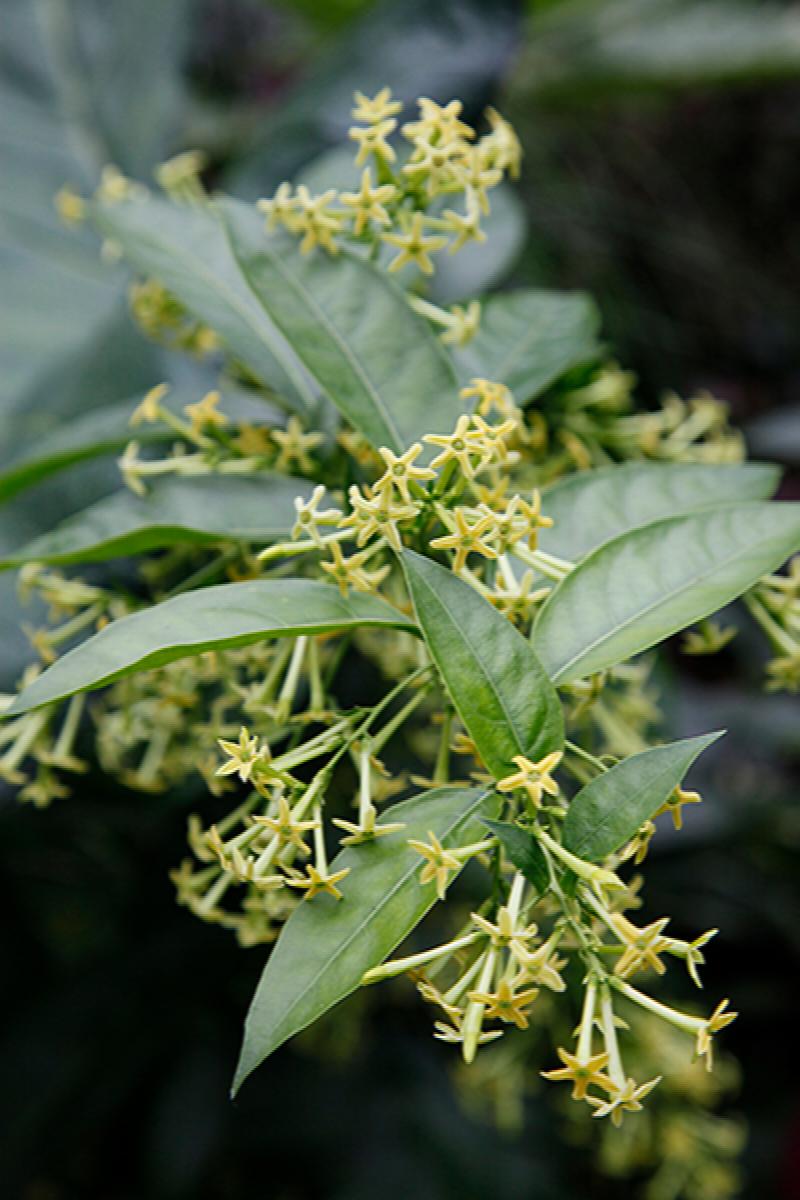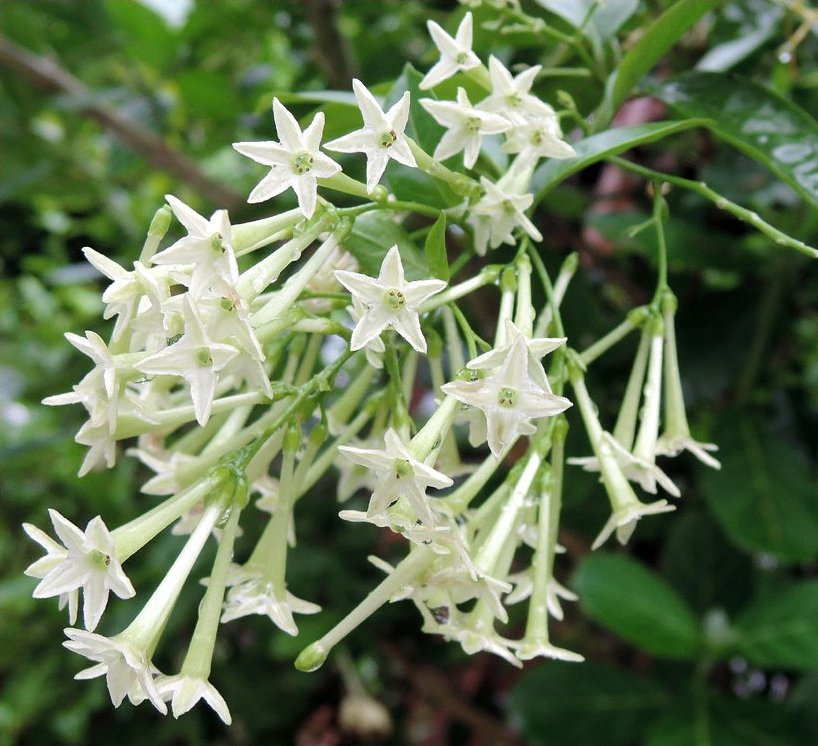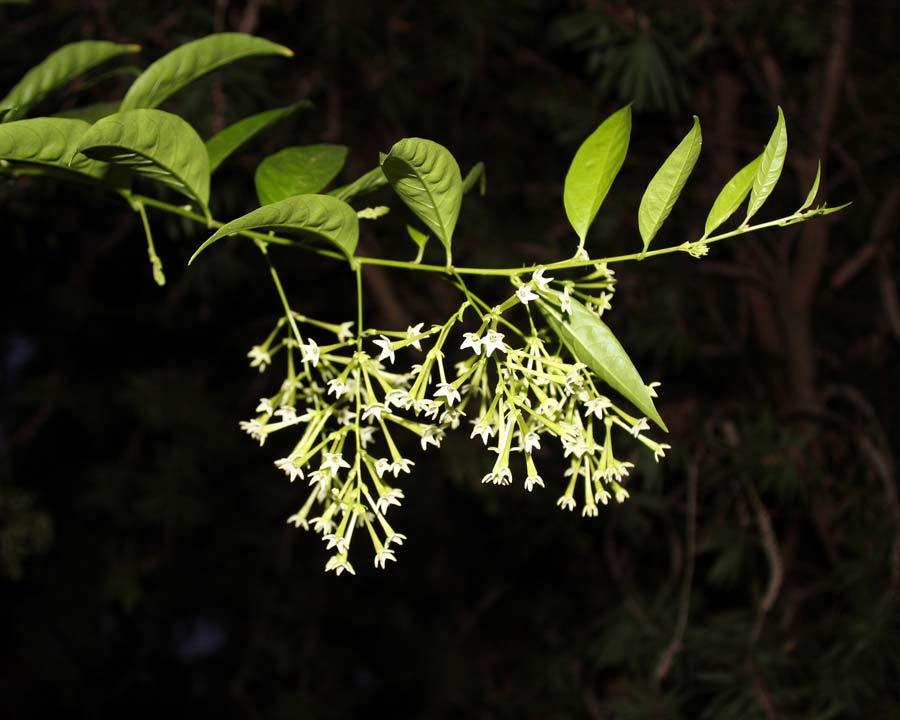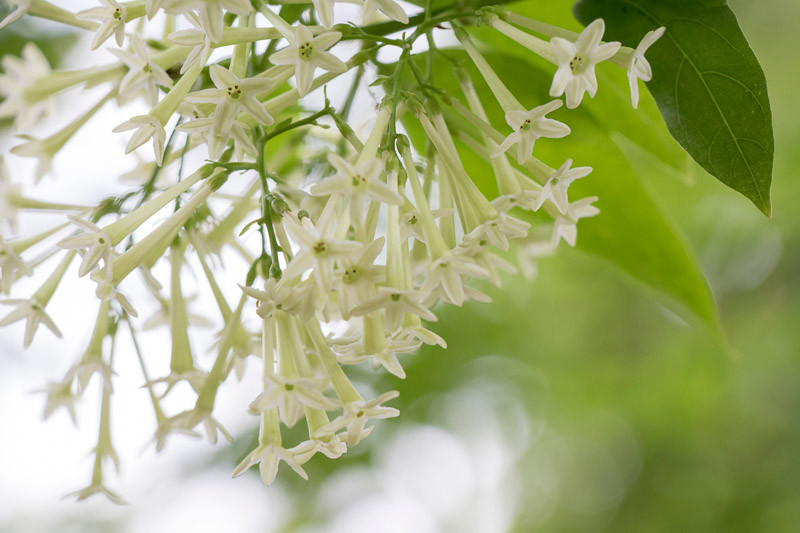
Cestrum Nocturnum “Night Queen or Nightblooming jasmine” Uber Nursery
CESTRUM nocturnum Commonly known as Night jasmine, Night-blooming jasmine Highly fragrant white flowers tinged with pale green, releasing most perfume in the evening. Conservatory shrub Further Reading.. Cestrum - Growing Guide

Night Blooming Jasmine (Cestrum nocturnum)
Cestrum nocturnum is an evergreen woody shrub with slender branches growing to 4 m (13 ft) tall. The plant is multi-branched and heavily foliated. The leaves are simple, narrow lanceolate, 6-20 cm (2.4-7.9 in) long and 2-4.5 cm (0.79-1.77 in) broad, smooth and glossy, with an entire margin.

Cestrum nocturnum Night Blooming Jasmine Hello Hello Plants
Cestrum nocturnum ( Night Blooming Jasmine ) C. nocturnum is an evergreen shrub with night-blooming white flower clusters. As the flowers open in the evening, a lovely, bold fragrance is emitted. Likes constantly moist soil and full sun. Can tolerate some shade.

Cestrum nocturnum, Nightblooming Jasmine in GardenTags plant encyclopedia
Night blooming jasmine (Cestrum nocturnum) is a tropical, evergreen shrub that is famous for its sweet smell. The look of the plant is unpretentious. It has clusters of tubular flowers and pointy, dark green leaves. But if you walk by the plant during the evening hours, you will get a whiff of a sultry, sweet scent that is distinctive to this.
AP Biology Plant Project NightBlooming Jasmine, Cestrum Nocturnum
Noteworthy Characteristics. Cestrum nocturnum, commonly called night jessamine or lady of the night, is an evergreen shrub native to lowland thickets, woodland openings, and disturbed areas in the West Indies and from southern Mexico south to Panama.It is widely planted as an ornamental in tropical regions around the world. Mature plants will reach 3-13' tall with a similar spread and an.

Cestrum nocturnum L. Plants of the World Online Kew Science
This species is accepted. The native range of this species is Mexico to Venezuela. It is a shrub or tree and grows primarily in the wet tropical biome. It is used as a poison, a medicine and invertebrate food, has environmental uses and social uses and for food. Taxonomy.

Night Blooming Jessamine, Cestrum nocturnum, Monrovia Plant
Cestrum nocturnum is an annual woody flowering plant with slim branches that can reach a height of 4 m (13 ft). The plant has many components and is strongly foliated. The leaves are simple, limited petiolate, 6-20 cm (2.4-7.9 in) long and 2-4.5 cm (0.79-1.77 in) vast, seamless, and shiny, and have an entire edge.

Fragrant NightBlooming Jasmine Cestrum nocturnum 15 Seeds
Keep Your Plant Healthy. Before night-blooming jasmine is well established, it needs deep, weekly watering - though beware of soggy or excessively salty soil conditions. If the weather is hot, or if you have a potted plant, check each day for dry soil, and then water accordingly. Prune annually, before or after blooming is finished between.

Jasmine NIGHT BLOOMING Cestrum Nocturnum Plant Fragrant Green White Flowers Starter Size 4 Inch
Cestrum nocturnum L. First published in Sp. Pl.: 191 (1753). This species is also widely used as a medicinal, hedging and ornamental plant throughout the world, but has been implicated in fatal poisoning of horses. Distribution Flora districts: U2 K4 T2 T3 T6 Z (fide U.O.P.Z.) Range: Native to West Indies or Central America, widely.

Cestrum nocturnum
By far the bestselling cestrum in our catalogue is firmly a greenhouse plant and called Cestrum nocturnium or 'night jasmine'. It is reputed to have aphrodisiac properties which may well explain its popularity. Even in the greenhouse this evergreen plant may be cut back to ground level in winter but it will soon reshoot.

Ohio Grown Night Blooming Jasmine Plant Cestrum nocturnum 4" Pot Buy Online in United Arab
Prized for its heady fragrance, Cestrum nocturnum (Night-Blooming Jasmine) is a bushy evergreen shrub adorned with gracefully arching branches lined with glossy, pointed, dark green leaves. In summer, a profusion of slender, tubular, creamy-white flowers, 1 in. long (2.5 cm), open in the evening and close the following morning.

Cestrum nocturnum/Raat Ki Rani Flowering Plants Exotic Flora
Night Jasmine Information Commonly known as night-blooming jasmine, night-blooming jessamine, or lady-of-the-night ( Cestrum nocturnum ), it is not a true jasmine, at all, but is a jessamine plant of which are members of the nightshade (Solanaceae) family along with tomatoes and peppers.

Cestrum nocturnum (NightBlooming Jasmine)
Night-Blooming Jasmine (Cestrum nocturnum) is a captivating woody shrub that originates from the West Indies and belongs to the Solanaceae family. Although not a true jasmine, this fascinating plant has earned its name due to the alluring greenish-white or yellow tubular flowers that unfurl at night, releasing a mesmerizing scent that can travel hundreds of feet.

Night Blooming Jasmine Plants For Sale Cestrum Nocturnum Easy To Grow Bulbs
Night-blooming jasmine ( Cestrum nocturnum) is a flowering plant that belongs to the nightshade ( Solanaceae) family. Night-blooming jasmine is an evergreen shrub that displays glossy green leaves and tiny white flowers. Native to the West Indies in the Caribbean, night-blooming jasmine grows best in USDA hardiness zones nine through eleven.

Cestrum nocturnum, Nightblooming Jasmine in GardenTags plant encyclopedia
Cestrum nocturnum lady of the night A bushy, evergreen shrub to around 4m with arching stems bearing ovate leaves and panicles of greenish-tinged, creamy-white, tubular flowers that release a sweet and musky perfume at night. Flowers may be followed by clusters of small, white fruits Other common names night jessamine night-blooming jasmine

Cestrum nocturnum Garden Variety
Night-blooming jasmine ( Cestrum nocturnum) is a fast-growing woody shrub. Part of the Solanaceae family, which also includes potatoes and tomatoes, the plant isn't a true jasmine. It gets its name from the tubular greenish-white or yellow flowers that emit a highly fragrant scent at night and are attractive to butterflies and other pollinators.